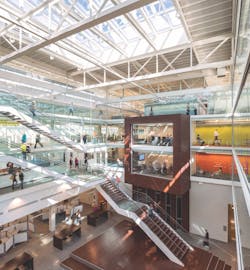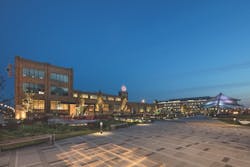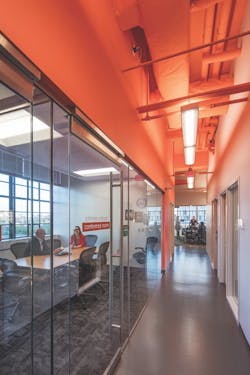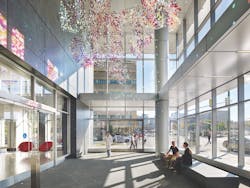Movers + Shapers: Innovation Superchargers
Later this year, the Wake Forest Innovation Quarter, a hub for biomedical research and information technology nestled in North Carolina’s Piedmont Triangle, will reopen Bailey Power Plant—an 80-year-old facility that’s been dormant for two decades—as a 110,000-sf mixed-use and entertainment space that complements the 1.6-acre Bailey Park across the street.
The power plant is the sixth building within the Quarter that Wake Forest has revitalized in partnership with Wexford Science & Technology, a Baltimore, Md.-based developer that has carved out a niche for itself as a creator of “knowledge communities.” These neighborhoods go beyond the conventional office/lab/incubator mix found within most innovation centers, to include work-live-play elements that entice entrepreneurs and their companies to relocate, stay, and expand locally.
Over its 20-plus years in business, Wexford has developed a baker’s dozen of knowledge communities in such markets as Miami, St. Louis, Mo., Philadelphia, and Chicago. One of its latest projects is a historic redevelopment of The Chesterfield, a former cigarette factory in Durham, N.C.’s vibrant Brightleaf District downtown. In collaboration with Duke University, Wexford is transforming this 286,000-sf building to become the district’s “center of gravity” for life science and technology. Along with new offices, labs, and a six-story, 4,500-sf interior atrium, The Chesterfield will feature street-level retail, and is a stone’s throw from Amtrak and light-rail stations.
Wexford is now poised to take its concept to universities west of the Mississippi River, after becoming a management-owned and -operated company last year, with a strategic capital partner in tow.
Thomas Osha, Wexford’s Senior Vice President of Innovation and Economic Development, is spending more time these days meeting with academic, research, and business leaders in places like Austin, Phoenix, and Portland, Ore. He says that Wexford prefers to align with institutions that already have strong reputations as research universities and share its view of innovation centers as economic catalysts by developing broader communities “where startup companies have a place to grow.”
Breaking Free
It was 11 years ago when Jim Berens, who at the time was President of Townsend Capital, acquired Townsend’s university development business. Those assets became Wexford Science & Technology in 2007. Soon after, Berens, Wexford’s CEO, started searching for a capital partner to help finance his expansion objective: to bring Wexford to one million sf of developed space.
For a while, that partner was Redwood Capital. Then, in 2013, Wexford merged with BioMed Realty Trust. That marriage, however, took a detour last year, when Blackstone Real Estate Partners bought BioMed. Wexford found itself with a new parent whose growth strategy “wasn’t a good fit for us,” says Osha.
Last September, Wexford broke free as a management-owned company when Ventas, a real estate investment trust, acquired Wexford’s $1.5 billion real estate portfolio from Blackstone’s BioMed affiliate. Wexford, says Osha, continues to manage and operate that portfolio. Ventas is a strategic capital partner for Wexford’s new projects, of which Wexford owns the land and structures.
An ‘innovation ecosystem’
Typical of the projects in Wexford’s wheelhouse is the Wake Forest Innovation Quarter in Winston-Salem, N.C., which encompasses 123 companies, five academic institutions, and 3,500 employees. Wexford is the largest among eight landlords.
Wexford’s relationship with Wake Forest dates back to 2009, when it worked with the university’s Medical Center to redevelop a former tobacco factory that was part of 30 downtown acres R.J. Reynolds had donated to the school.
Over the ensuring eight years, Wexford and Wake Forest have redeveloped six buildings that form what Eric Tomlinson, the Quarter’s President, calls “an innovation ecosystem.” They include Biotech Place, a 242,000-sf facility with wet labs, classrooms, a conference center, offices, and a business accelerator, and the 167,940-sf Bowman Gray Center for Medical Education, which houses programs from the Wake Forest School of Medicine. The Bailey Power Plant is the last historic building to be converted.
The redevelopment of 635@Vine, with 242,740 sf of space, was pivotal to the Innovation Quarter’s evolution, because it became the corporate headquarters of Inmar, a marketing analytics and big-data provider. “Moving its headquarters there made the Innovation Quarter more than just a medical center,” says Will Partin, Wexford’s Senior Director of Development. The benefits to Inmar were mutual, as the relocation allowed it to pursue innovation businesses within the Quarter as clients.
Wexford and Wake Forest—which currently controls 130 acres of land in Winston-Salem—are now huddling about their next redevelopment project: the creation of a second downtown on 45 acres between two highways that, if realized, would double the size of the Innovation Quarter.
Tomlinson calls Wexford “an amazing partner” with which Wake Forest “is joined at the hip” in development, design, and construction meetings that concern the Quarter. “They have been willing to share success factors with us, and we are now part of a pantheon of 13 innovation centers,” says Tomlinson. “It’s been a complete pleasure working with them.”
Thumbs up from AEC firms
Wexford gets high grades from AEC firms that have worked on its projects, too.
“I wish all developers were like Wexford,” says Tracy Hart, President and CEO of general contractor Tarlton Corporation, whose first project with Wexford was the 109,730-sf Bio-Research & Development Growth Park at the Danforth Plant Science Center in St. Louis. “They are a sophisticated buyer of construction services, and astute about what makes a good product.”
Andy Kovarik, Tarlton’s Project Director, says Wexford likes to bring its Building Teams together early in a project’s design process, and prefers to have tenants in place before starting a new building.
HOK designed the core and shell and the majority of the tenant spaces for @4240, a 202,500-sf office and lab building that’s part of the 200-acre Cortex Innovation Community in St. Louis, which Wexford developed with Washington University. Lance Cage, LEED AP, Managing Principal at HOK’s St. Louis office, observes that Wexford is particularly adept at working “with different parties, and getting everyone aligned in terms of what needs to be done.”
The Wexford projects HOK has designed “have lots of amenities and open space, which make them desirable to tenants,” says Cage. He notes, too, that Wexford’s buildings have “built-in synergies that encourage tenant interaction. A couple of small law firms are leasing space in Cortex just for that reason.”
Cage says that Wexford “fought” to get the city’s MetroLink to connect Cortex to the airport to make the community more accessible to people arriving from other states or countries.
ZGF Architects’ first project with Wexford was the design for the University of Miami Life Sciences & Technology Park, completed in 2011. “Wexford knows what it’s doing and really knows its product,” says Ted Hyman, FAIA, Managing Director in ZGF’s Los Angeles office.
Hyman believes Wexford has turned to ZGF for multiple projects because of its 30 years’ experience designing research buildings, and its work in the tech sector over the past decade. But the relationship has been reciprocal. ZGF brought Wexford’s cost-effective developer model, which emphasizes design flexibility, to another client—the University of California, Los Angeles—which is converting nine of 12 floors within the 443,000-sf South Tower of its Center for Health Sciences to research lab space. “What we’re delivering will be cheaper to operate and offers a superior lab environment,” Hyman asserts.
Targeting ‘serial entrepreneurs’
ZGF designed the interior spaces for several buildings at uCity Square in Philadelphia, one of Wexford’s most ambitious projects to date, and one that could keep the developer busy for the next several years.
University City is an ongoing urban renewal project in West Philadelphia that dates back to the 1950s. It consists of several neighborhoods, and its eastern side includes the campuses for the University of Pennsylvania and Drexel University, the Science Center, and the 30th Street Station.
Wexford first got involved with University City in 1999, when, as Townsend Capital, it purchased a building at 3535 Market Street, which it eventually flipped. Townsend also developed and constructed 3701 Market in 2000-2001.
A few years ago, the Science Center—a nonprofit consortium of 31 university and private research entities—rebranded itself as uCity Square, which consists of the Science Center’s combined real estate holdings on its 17-acre legacy campus, and 14 adjacent acres that Wexford and Drexel purchased under a joint venture agreement in 2014.
Those real estate assets include 3711 Market, a 154,845-sf building with offices and wet labs, as well as innovation spaces like Quorum, an entrepreneurial hangout; Port, a wet-lab incubation program; and QED, a seed financing program for life science and technology companies.
The 14-story 3737 Market, which Wexford developed with the Science Center, has 334,000 sf of clinical, medical, wet lab, and office spaces. It’s anchored by Penn Presbyterian Medical Center of UPenn’s Health System and Spark Therapeutics, an offshoot of the Children’s Hospital of Philadelphia.
Under construction, for delivery next year, is 3675 Market, a 14-story, 343,465-sf building, with space for labs, clinical, educational, and retail tenants. The Science Center will relocate its headquarters into 50,000 sf of this building and expand an after-school program that provides lab access to middle and high school students. Quorum will rent 15,000 sf, tripling its current space. And Cambridge Innovation Center—a tenant in a number of Wexford’s knowledge communities—will occupy 127,000 sf.
This building and its infrastructure are designed “to reintroduce the grid to the neighborhood,” says Joseph Reagan, AIA, Wexford’s Senior Vice President of Development, by connecting the north and south sides with a pedestrian path—37th Street—that had run through this site before it was demolished in the 1960s to make way for the construction of three school buildings.
Including 3675 Market, Wexford and its partners are working to expand uCity Square to 4.5 million sf, from its current 2.7 million sf, over the next 10–15 years. As planned, this expansion would include the construction of a new K-8 school that would be run by the school district, and commercial buildings on parcels at 3800 Market and 3400 Market, surrounded by residential, retail, and recreational spaces. All told, uCity Square will cost almost $1 billion to complete and create 3,700 permanent jobs.
“We’ve had all flavors of transactions with Wexford, and they’ve been an excellent partner,” says Stephen Tang, PhD, President and CEO of University City Science Center. “They have a profound knowledge of the sector, and are exceptional listeners and deal makers.”
Tang notes that uCity targets “serial entrepreneurs” looking for places to both expand and live. He says that at least five startups have “graduated” from incubator space at the Science Center to commercial space in one of uCity Square’s buildings.
Parenthetically, Tang says uCity Square is well suited for a city that has enjoyed the highest influx of Millennial-age workers of any major metro in the country.
Driving urban economic growth
City Square is a prime example of how Wexford is growing its business organically. Osha foresees housing and hospitality as important additions to its knowledge communities, some of which already include residential in their mixes.
Wexford is also looking beyond its existing communities toward national expansion. Osha, who travels 280 days out of the year, says he gets “lots of calls” from colleges across the country. Research universities are Wexford’s preferred development partners because, as he explains, “they often have land all over, and they rarely get rid of it.”
But Wexford isn’t leaping at just any offer. Osha says the firm is only interested in partnering with universities for which cultivating a knowledge community is a priority.
The good news is that more cities now see knowledge communities and their ilk as economic engines. And advocates like the Brookings Institution “have helped put innovation centers on the map for mayors and even governors,” says Osha.



